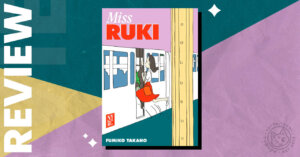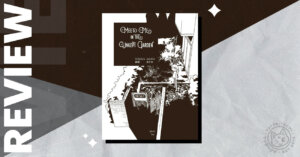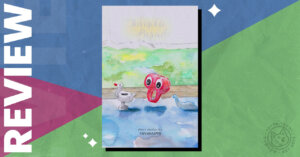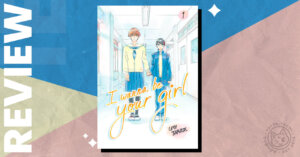Miss Ruki is kind of a weirdo. She’s unfashionable, uncoordinated and yet wholly self-possessed. She drives her stylish friend Ecchan up the wall. Shouldn’t Ruki know better than to roll her pants up her legs like a kid, make funny faces at the library, or keep chilli oil in the toolbox? Trends roll off her like water on a duck’s back. Yet Ecchan knows deep down that’s exactly what makes Ruki cool.
A straightforward book
Per the translator, Alexa Frank, Miss Ruki was originally published in the pages of the woman’s magazine Hanako between 1988 and 1992. It’s a straightforward book. Every strip has sixteen panels, including the title. Ruki and Ecchan are the main recurring characters; a few others appear in the opening pages, but are swiftly phased out. There are no ongoing storylines. You’re here to watch Ruki and Ecchan do simple things like buy groceries, drink tea, and go to the library.
So, why would a series like this be scooped up by New York Review Comics, which prides itself on publishing stylish work by artists like Joe Kessler and Yoshiharu Tsuge? Well, Miss Ruki is drawn by Fumiko Takano. Manga readers in the United States have almost certainly never heard of her, but they may recognize a few of her most ardent fans: Taiyo Matsumoto, Kyoko Okazaki, Katsuhiro Otomo. “If you’re familiar with manga,” Frank writes, “you may realize this is quite the lineup.”
A stylish Hanako reader
The appeal of Miss Ruki is tough to describe as a critic because it is so simple. Ruki is a funny character to follow, with her noodle-shaped limbs and bright smile. Ecchan, by comparison, is admirable in how committed she is to trends, but also relatable in how she reacts when her best laid plans blow up in her face. These characters are polar opposites and yet clearly like and respect each other. Their interactions are endlessly entertaining.
The strip’s lack of scope or continuity means you can turn to any page and have a good time. Yet it also works on multiple levels. As a stylish Hanako reader, you might shake your head at Ruki just like Ecchan does. You might moan along with Ecchan when the sudden appearance of a handsome man shocks her into silence. Or you might even feel envious of Ruki, who is happily herself in the face of Japan’s overwhelming consumer culture fuelled by the 1980s financial bubble.
Phone cord
Takano’s characters are funny and relatable because she is very good at drawing them. For instance: Ecchan plays a game with Ruki by showing her a random object quickly and asking her to guess what it is. Tanako draws the motion as afterimages extending from Ecchan’s closed hand forming a circle. She repeats the trick two more times, then reveals the gag: a plate of snacks arranged in the same circular shape. “Ohh, gyoza!” Ruki cries. To which Ecchan snaps, “They’re crepes!”
Or look at a later strip, where Ruki is advising Ecchan over the phone how to set the timer on her electric rice cooker. Ruki is determined to help her friend, but the instructions for her rice cooker are pasted on the opposite wall. So, she pulls the phone cord as far as she can, leaves it behind when it proves insufficient, and then yells at the receiver lying on the floor so that Ecchan can hear her. Cut to Ecchan, who has been speaking into a handheld this whole time.
Black magic
This gag would not work if it was just dialogue. It works because Takano knows body language and can build a joke that rests not just on funny movements, but on movements that are funny because they are characteristic. We laugh when Ecchan sticks her butt over a stove (Hibuttchi!) because we know she would never do it in public. Similarly, when Ruki makes a funny face in the library, it’s even funnier because she looks so uncharacteristically serious.
Takano’s ability shades into black magic the further you dig. There’s a strip in this collection where the appeal is in watching Ecchan’s motions as she lies on the floor drinking a cup of tea and then struggles to refill a teacup. I’m convinced reading this that anime director Naoko Yamada is a Fumiko Takano fan; Takano even injects some foot acting, a classic Yamada tell. (Takano also provided original character designs for Yamada’s 2021 anime series The Heike Story.)

Verdict
You could go on for hundreds of pages trying to understand how Takano captures the appeal of movement through space on the page. But is that really necessary? Miss Ruki boasts flawless technical execution, but it is first and foremost entertaining and accessible. Describing it via buzzwords like “healing manga” almost feels like a waste. Ruki’s great strength, after all, is that she is herself in defiance of contemporary trends. I could say the same of this book.
Miss Ruki is available on Bookshop, Amazon and Barnes & Noble.
If you liked Miss Ruki, you may like…
- Hirayasumi, by Keigo Shinzo
- Yotsuba&!, by Kiyohiko Azuma
- Talk to My Back, by Murasaki Yamada
Credits
Story and Art by Fumiko Takano
Translation and Essay by Alexa Frank
Cover Design by Ella Gold
Typesetting by Anika Banister
Published in English by New York Review Comics
A special thanks to New York Review Comics for providing us with a review copy of this title. Receiving a review copy of manga has in no way altered the opinions expressed in this article.
Article edited by: Anne Estrada

Featured Sponsor - JAST
The sweetest romance and the darkest corruption, the biggest titles and the indie darlings; for visual novels and eroge, there's nowhere better.
Big thank you to our supporters
From their continous support, we are able to pay our team for their time and hard work on the site.
We have a Thank-You page dedicated to those who help us continue the work that we’ve been doing.
See our thank you page




